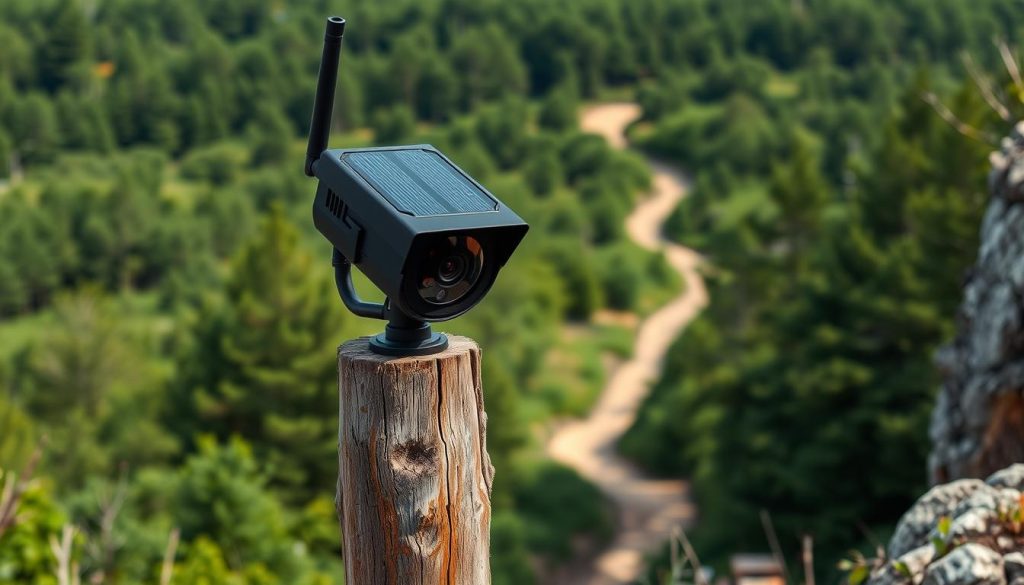Remote surveillance is becoming increasingly essential, especially in rural areas where traditional systems may not suffice. In Singapore, the demand for reliable monitoring solutions has grown significantly. These systems not only enhance safety but also contribute to environmental sustainability.
Studies show that modern surveillance tools can drastically reduce crime rates. For instance, trials in Aberdeen reported a 72% reduction in burglaries after implementing these systems. This highlights their effectiveness in safeguarding properties.
Energy efficiency is another key advantage. Brands like Milesight have developed systems that consume as little as 2 watts per day, making them both cost-effective and eco-friendly. With options like the eufy 4G LTE S330, which boasts a 9,400 mAh battery, users can enjoy uninterrupted monitoring.
This guide will explore top brands such as Reolink, eufy, and Vosker, helping you make an informed decision. Whether you prioritize power, durability, or advanced features, we’ve got you covered.
Key Takeaways
- Remote surveillance systems are highly effective in reducing rural crime.
- Modern systems are energy-efficient, consuming minimal power.
- Brands like Milesight and eufy offer sustainable and reliable solutions.
- This guide will help you choose the best system for your needs.
What is an Off-Grid Cellular Security Camera?
Modern monitoring solutions are designed to work independently of traditional infrastructure. Unlike traditional systems that rely on WiFi, these devices use cellular networks to stay connected. This makes them ideal for remote areas where internet access is limited or unavailable.
One of the core components of these systems is their independent power supply. They can operate using solar energy or rechargeable batteries, ensuring continuous functionality even during power outages. For example, the Reolink Go Plus uses a combination of solar panels and batteries to maintain operation.
These systems transmit data via 4G networks, providing reliable connectivity in areas where other options fail. Even when the network is down, they store footage locally on SD cards, ensuring no critical moments are missed.
Typical use cases include farms, construction sites, and marine properties. These locations often lack traditional infrastructure, making independent systems a practical choice. Whether you need to monitor livestock or secure a construction site, these devices offer a versatile solution.
Why Choose an Off-Grid Cellular Security Camera?
With rising rural crime rates, reliable surveillance tools are more critical than ever. Independent monitoring systems provide a robust solution for securing hard-to-reach areas. These devices are designed to function without traditional infrastructure, making them ideal for remote properties.
Enhanced Security in Remote Areas
Rural crime is a growing concern globally. According to the NFU Mutual Report, rural crime in the UK cost £52.8 million in 2023. This highlights the need for effective monitoring solutions in isolated locations. In Singapore, rural areas face unique challenges, such as limited access to power and internet. Independent systems address these issues by using cellular networks and alternative power sources.
Modern devices also feature anti-tamper measures, such as encrypted cellular transmission. This ensures that data remains secure, even if the system is compromised. For example, the eufy S330 prevented a car theft at Fisherman’s Quay by sending instant alerts to the owner. Such real-time notifications are invaluable for preventing losses.
Reliability During Power Outages
One of the standout features of these systems is their ability to operate during grid failures. Battery redundancy ensures continuous functionality, even when the main power source is unavailable. Solar panels further enhance reliability, as seen in the case of an eufy user who maintained over 85% battery life during winter.
These systems are not just about security; they’re about peace of mind. Whether you’re protecting a farm, construction site, or marine property, independent monitoring tools offer a versatile and dependable solution. For more insights, check out our off-grid security camera system guide for.
Key Features to Look for in an Off-Grid Cellular Security Camera
Choosing the right monitoring system involves understanding its key features. From power options to advanced functionalities, each aspect plays a crucial role in ensuring reliable performance. Here’s what to consider when evaluating your options.
Solar-Powered vs. Battery-Powered Options
When it comes to power sources, you’ll often find two main choices: solar panels and batteries. Solar-powered systems, like those from Reolink, harness sunlight to keep the device running continuously. These are ideal for areas with ample sunlight, such as Singapore.
On the other hand, battery-powered options, such as the Reolink Argus 2E, offer flexibility and can last up to two years on a single charge. However, they may require occasional maintenance. Consider your location and energy needs to decide which option suits you best.
Weather Resistance and Durability
Singapore’s tropical climate demands devices that can withstand heavy rain and humidity. Look for cameras with an IP67 rating, which ensures they can operate in temperatures ranging from -20°C to +60°C. This makes them durable enough for monsoon seasons and extreme weather conditions.
For example, the Milesight series is designed to handle harsh environments, making it a reliable choice for outdoor use. Durability is key to ensuring your system remains functional year-round.
Night Vision and Motion Detection
Advanced features like night vision and motion detection are essential for round-the-clock monitoring. Devices such as the Reolink Argus 2E offer a 120° viewing angle and a night vision range of up to 33 feet, ensuring clear visibility in low-light conditions.
Additionally, AI-powered motion detection, as seen in Milesight’s Smart IR, dynamically adjusts illumination to capture precise details. This minimizes false alerts and ensures you only receive notifications for relevant activity.
- Compare solar panels and batteries to determine the best power source for your needs.
- Opt for IP67-rated devices to ensure durability in Singapore’s climate.
- Prioritize systems with advanced night vision and motion detection for comprehensive monitoring.
How to Choose the Right Off-Grid Cellular Security Camera for Your Needs
Selecting the ideal monitoring solution requires careful consideration of your specific needs. Whether you’re securing a farm, construction site, or marine property, understanding your requirements is the first step. This section will guide you through the key factors to consider when choosing the right system.
Assessing Your Property’s Requirements
Start by evaluating the size and layout of your property. Calculate the coverage area and match it with the camera’s field of view (FOV) specifications. For example, a security camera with a 120° FOV is ideal for wide spaces.
Next, consider the power source. Solar panels are a great option for sunny locations like Singapore. However, if your area has limited sunlight, a battery-powered system might be more practical. Ensure the solar panel size aligns with local sunlight conditions for optimal performance.
Finally, think about durability. Singapore’s tropical climate demands systems that can withstand heavy rain and humidity. Look for devices with an IP67 rating to ensure they can handle extreme weather.
Considering Connectivity Options
Reliable connection is crucial for effective monitoring. Compare Singapore’s telco 4G coverage maps to ensure your area has strong signal strength. Devices like the Vosker V300 offer dual SIM capabilities, providing backup connectivity if one network fails.
Data usage is another important factor. The Reolink Go Plus, for instance, uses approximately 1GB of data per month. Plan your data budget accordingly to avoid unexpected costs.
If you’re setting up multiple cameras, plan your network carefully. Ensure each device has adequate coverage and connectivity. For larger properties, consider cameras with pan-tilt features, like the Reolink Go PT Plus, to maximize monitoring efficiency.
- Evaluate your property’s size and match it with the camera’s FOV.
- Choose a power source that suits your location’s sunlight conditions.
- Ensure the device is durable enough for Singapore’s climate.
- Compare 4G coverage maps and plan your data usage.
- Plan multi-camera networks for comprehensive coverage.
Installation Tips for Off-Grid Cellular Security Cameras
Proper installation ensures your monitoring system works efficiently. Whether you’re setting up at home or in remote areas, following best practices guarantees optimal performance. This section covers placement strategies and setup options to help you get the most out of your device.
Optimal Placement for Maximum Coverage
Placement is critical for effective monitoring. For construction sites, a height of 9 meters is ideal for wide coverage. This ensures the camera captures all activity without blind spots. In residential areas, position the device to cover entry points like doors and windows.
For solar panels, angle them to maximize sunlight exposure. In Singapore’s equatorial climate, a 10-15° tilt works best. This ensures consistent power supply for uninterrupted operation. Anti-theft mounts are also recommended for public spaces to prevent tampering.
DIY Installation vs. Professional Setup
DIY setups are cost-effective but require technical knowledge. For solar panels, you’ll need to convert DC to AC power, which can be complex. Professional installation, on the other hand, ensures proper wiring and weatherproofing. In Singapore, this typically costs between SGD 150-300 per device.
Weatherproofing is essential for durability. Use conduits to protect cables from rain and humidity. Before finalizing the setup, test signal strength to ensure reliable connectivity. This step is crucial for remote locations with limited network access.
- Height vs. coverage: 9 meters is ideal for construction sites.
- Optimize solar panel angles for equatorial sunlight.
- Use anti-theft mounts in public areas.
- Compare DIY and professional costs in SGD.
- Weatherproof cables with conduits for durability.
- Test signal strength before finalizing installation.
Maintaining Your Off-Grid Cellular Security Camera
Keeping your monitoring equipment in top shape ensures long-term reliability. Regular maintenance not only extends the lifespan of your devices but also guarantees uninterrupted performance. Here’s how to keep your systems running smoothly.

Regular Cleaning and Firmware Updates
Dust and debris can affect the performance of your cameras. Clean the lens and solar panels every six months to ensure clear visibility and optimal power absorption. Use a soft cloth to avoid scratches.
Firmware updates are equally important. They enhance functionality and fix bugs. Check for updates every three months or enable automatic updates if your device supports it. This keeps your security system up-to-date with the latest features.
Troubleshooting Common Issues
Connectivity problems are a common concern. A factory reset resolves 80% of these issues. Simply follow the manufacturer’s instructions to reset your device without losing critical settings.
False motion alerts can be frustrating. Adjust the sensitivity settings or reposition the camera to minimize unnecessary notifications. Regularly monitor battery health and replace it every 3-5 years to avoid sudden failures.
- Create a maintenance checklist: lens cleaning, panel wiping, and firmware updates.
- Diagnose false motion alerts by adjusting sensitivity or repositioning the device.
- Monitor battery health and replace it every 3-5 years.
- Prepare for storms by securing outdoor equipment and checking weatherproofing.
- Format SD cards every six months to ensure reliable storage.
Making the Most of Your Off-Grid Cellular Security Camera
Maximizing the potential of your monitoring system ensures enhanced safety and efficiency. Integrating IoT sensors can boost perimeter security, while multi-user access controls allow shared management. These features make your setup more versatile and user-friendly.
Advanced analytics, like Milesight’s traffic monitoring, provide valuable insights. AI-powered tools can even track wildlife or detect unusual activity. Cloud storage with encryption ensures your data remains safe and accessible.
For PTZ models, automated patrol patterns optimize coverage. Emergency response protocols can be tailored to specific needs. Beyond surveillance, these systems can monitor weather or track assets, adding extra value to your investment.

